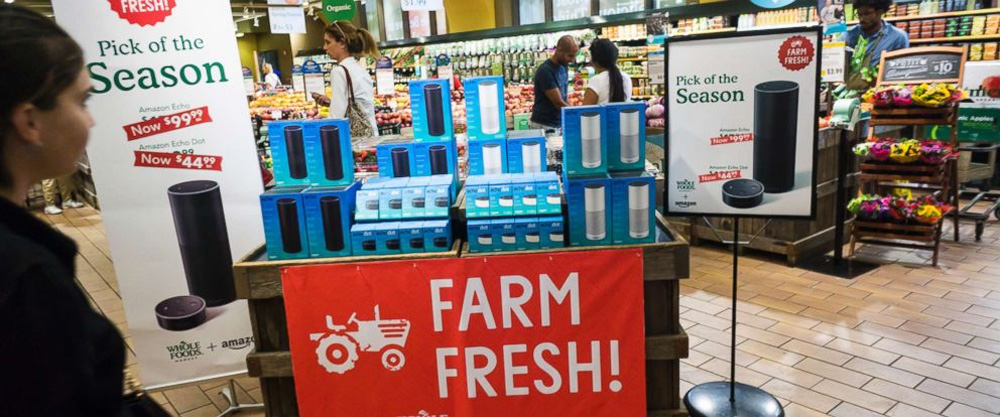How the confrontation between Walmart and Amazon determines the future of retail

The struggle of two major US supermarkets, offline and online, six months ago went into the active stage. For half a year Walmart has been actively trying to rebuild its entire business, investing billions to give Beosos a battle in the field of e-commerce. Now for the confrontation of Amazon, it collects "Dream Time". Combines with Japanese Rakuten to produce Better Kindle e-readers, Waymo AI machines, Microsoft cloud services, Uber and Lyft car sharing, and Postmates delivery service. And in the spring, with the support of Google for $ 15 billion, even bought an Indian store Flipkart - only to kill the Amazon bet. But the main battle is still ahead: the market for $ 800 billion, with which no company really yet understands what to do.
The enemy of my enemy is my friend, or how Walmart teams up with tech companies
In July, Walmart announced a strategic partnership with Microsoft. All its services will be transferred to Microsoft Azure and Office 365, and Microsoft will also help in the development of artificial intelligence for “cashless” supermarkets ( similar to Amazon Go ).

Amazon Go supermarket, working without cashiers and cashiers
The creator of Windows began work on this technology in June, and Walmart has been trying to make progress in this direction since mid-2017. So far, they both have no share of what Amazon has managed to create. Walmart did not even provide a working prototype - while Jeff Bezos’s supermarkets are already working successfully, showing a minimum of errors in determining who bought the goods from them. But together Walmart and Microsoft are hoping to catch up and overtake a competitor in 3-5 years.
Smart supermarkets are far from the only front on which Walmart is preparing for a battle with Amazon. The other day, she announced plans to turn her daughter Vudu into a full-fledged rival Prime Video by the end of this year, with lots of movies and TV shows to choose from. The company also launched $ 1 billion tech-incubators in Texas and California to experiment with the development of cashless supermarket technology, artificial intelligence and computer vision. They will help her create personalized services to help with purchases, as well as smart drones and baskets to help customers find and select products.
The old large offline retail brand, one of the biggest on the planet, is desperately trying to stay in demand in a world that is rapidly moving towards online commerce and various additional services. Amazon was a pioneer in this business model. She has been losing money for many years, gradually building her logistics and crowding out competitors to win a dominant share in various markets. Now in the US, it controls books (through Kindle), online commerce (Amazon.com - 51% of all online sales in the States), shoes (Zappos), video streaming (Prime Video, Twitch) and cloud services (AWS). In parallel, the company has created the most successful loyalty program in the world, Amazon Prime, which lures customers into the company's ecosystem. She already has more than 100 million subscribers, who on average spend on Amazon.com 250% more than regular users.

')
But, poking their fingers into all these most delicious jars of jam, Amazon has made a lot of enemies. And Walmart now unites those around them. companies that will help her in the fight for a place in the sun.
Microsoft doesn’t like Amazon because of its AWS, which dominates the US cloud computing market. Google doesn’t like Amazon because of its refusal to place Google products in its store if they compete with Jeff Bezos’s own development (a special dispute has revolved around Google Home’s smart speakers). All of them are eager to help Walmart in the fight against their common enemy. Amazon beats any of them individually on their own field. But against the three companies from the Fortune 100 that help cover up each other’s shortcomings, even Bezos will have a hard time.
Apocalypse tomorrow
Last year, all the big supermarket chains in the US got a little uncomfortable. Jeff Bezos first went offline, buying Whole Foods organic food chain for $ 13.7 billion. At that time, buyers were not sure what to expect. Will this deal be a plus or a minus to supermarket customers? But since then, the situation has been determined. Bezos somehow transferred his strategy of minimum margins to the sphere of traditional retail. The cost of foods at Whole Foods has decreased by an average of 20%. The audience is delighted with this (and a bit shocked).

Whole Foods
And for Amazon, the situation is still profitable. Whole Foods went up sharply, winning the market from other companies that could not offer such prices. In the supermarkets, Amazon Echo smart speakers (the only electronics among vegetables, nuts and fruits) began to be sold, plus Whole Foods entered the Prime ecosystem. If you subscribe, in the supermarket you will be given an additional discount of 10%. According to experts, in the long run this may push Prime to buy another 10-15 million people. And that means even more active customers at Amazon.com itself and all its supporting services.
For Walmart, this story has become a real nightmare. Amazon swung at its territory. And it showed that traditional retail does not work. That it can offer products much cheaper, and at the same time still give users a bunch of bonuses. It became clear that the plan Bezos - to sell customers everything they want to buy. At any time of the day, with delivery to the house on the postal service trucks, and soon on the drones. All other sellers can only sit quietly and wait until Amazon eats them with giblets.

Amazon Echo is sold next to fruits and vegetables.
It was after buying Whole Foods Walmart head Doug Macmillon said that "this is a war, we have no way back", and began to invest billions in the development of his e-commerce. Walmart - the only network that, in theory, can fight with Bezos. It makes more money than any other corporation in US history. For 2018, its sales have already reached $ 500 billion. However, the margin is also minimal - due to astronomical operating costs. The company employs more than 2 million people, and it has a lot of physical areas that need to be maintained in proper condition.

Meanwhile at walmart
The saddest thing is that investors have already made their choice. In the future, Walmart almost no one believes. Although its sales and revenues are more than twice as high as Amazon, the company is worth only a quarter of its competitor. Amazon, although it still does not show profits, corresponding to an estimated $ 900 billion, is growing at 40% per year, while Walmart is difficult to add even 4%. In addition, she has no loyal buyers, a la Amazon Prime. If another supermarket with lower prices (for example, created by Amazon) opens next door, no one will stay with Walmart for additional services. In such circumstances, it is obvious which corporation has the future.
Hope in groceries
Both companies have grown very rapidly over the past two decades. But now Amazon has created a new paradigm for online retail, more convenient and profitable for buyers. These standards are quickly becoming the norm, and Walmart risks losing its customers. To compete with Amazon, it needs to correctly predict how people will buy products in the future. Find a market where it can still be more advanced and interesting to customers than Amazon.
And such a market exists. The sale of fruits, vegetables and other products is delivered to your home. No wonder Jeff Bezos bought Whole Foods. Groceries in the US - the market for $ 800 billion a year. And while still only 2% of these products are bought online. This has not yet become a habit of users, they prefer to choose their own fruits, for fear that they will bring something spoiled. But the demand for fast and convenient home products is growing. And so far only small companies like Blue Apron , delivering ready-made sets for cooking, satisfy him.

Dash button
Amazon sees a great opportunity, and is not going to miss it. She began selling the same kits (first homemade, and now from other "chefs") on her website . And she launched Prime Pantry 's program for the delivery of certain foods, often from Whole Foods. She also has a special gadget - a programmable Dash button , which can be set up for a quick purchase of everyday items like toothpaste, diapers, cereal, candy or laundry detergent. The idea is that the user will attach it to the wall in his kitchen, and when he sees that something is ending, he will simply click, and the next day he will get what he needs at his door (often saving 5-10 %).
But Walmart still has an advantage. The market is just beginning to develop, the habits of buyers are not formed. The company has 4,700 supermarkets across the country - within 10 kilometers, this gives it access to 90% of the US population. Amazon, with its giant warehouses, is forced to rely on postmen, and physically can not guarantee the delivery of products faster than 24 hours. And Walmart is able to organize the so-called "delivery of the last mile" on its own. This will give her a big advantage when selling perishable products online.

Grocery section at walmart
Now more than half of the income Walmart receives from groceries. And she is not going to concede this most important market. According to Reuters, she first worked out a plan to go through this “last mile” by the staff of the stores. Cashiers and security guards for an additional fee (on top of the standard $ 11 per hour) on the way home would carry the products to the customers who ordered them. After the test for 16 workers, the idea was abandoned. The payment was too low ($ 2 per package), and the staff did not feel particularly willing to drive and deliver something after an 8-hour workday. In addition, they all expressed concern about what would happen if they had an accident or lost the package while in their own car during off-hours.
Walmart is now testing delivery methods with the help of its friendly services. The other day, she announced a partnership with Waymo and Postmates. And groceries will be delivered on the way to new customers by drivers Uber and Lyft. The company also hopes to expand its own product delivery service ($ 9.95 for ordering any volume) to hundreds of cities by the end of 2018.
Ultimately, a victory in the “food battle” can determine the outcome of the entire large retail war. If Walmart gives the rival even this milestone, the company is unlikely to have a future. But if she succeeds in stopping Amazon’s progress at least on this front, with the support of other IT giants, she may gradually have chances of winning.


Source: https://habr.com/ru/post/419799/
All Articles